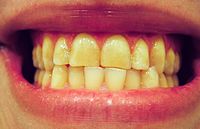
Photo from wikipedia
Rationale: With respect to improving the quality of oral rehabilitation, the management of keratinized mucosa is as important as bone condition for implant success. To enhance this management, a natural… Click to show full abstract
Rationale: With respect to improving the quality of oral rehabilitation, the management of keratinized mucosa is as important as bone condition for implant success. To enhance this management, a natural teeth-retained splint based on a patient-specific 3-dimensional (3D) printed mandible was used in vestibuloplasty to provide sufficient keratinized mucosa around dental implants to support long-term implant maintenance. Patient concerns: A 28-year-old male patient had a fracture of the anterior andible 1 year ago, and the fracture was treated with titanium. Diagnoses: The patient had lost mandibular incisors on both the sides and had a shallow vestibule and little keratinized mucosa. Interventions: In the first-stage implant surgery, 2 implants were inserted and the titanium fracture fixation plates and screws were removed at the same time. During second-stage implant surgery, vestibuloplasty was performed, and the natural teeth-retained splint was applied. The splint was made based upon a patient-specific 3D-printed mandible. At 30-day follow-up, the splint was modified and reset. The modified splint was removed after an additional 60 days, and the patient received prosthetic treatment. Outcomes: After prosthetic treatment, successful oral rehabilitation was achieved. Within 1 year and 3 years after implant prosthesis finished, the patient exhibited a good quantity of keratinized gingiva. Lessons subsections: The proposed splint is a simple and time-effective technique for correcting soft tissue defects in implant dentistry that ensures a good quantity of keratinized mucosa.
Journal Title: Medicine
Year Published: 2017
Link to full text (if available)
Share on Social Media: Sign Up to like & get
recommendations!